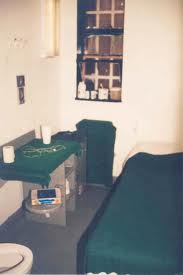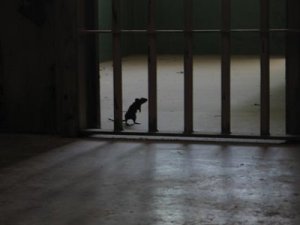By Five Mualimm-ak. Reprinted from the Albany Times-Union.
I am a survivor of 2,054 days of torture. And like many people who have endured such abuse, I suffer lasting psychological effects.
I often experience memory loss and flashbacks. It’s sometimes hard for me to focus. I get upset and angry easily, and have abnormal reactions to ordinary things. I find it difficult to sleep. I do not like being touched, and have difficulty connecting to people. I suffer from depression.
The torture I endured did not take place in some foreign land, or at the hands of a vicious psychopath. It happened right here in New York state, amidst communities of decent, law-abiding people. My torture consisted of five years in solitary confinement in New York’s prisons.
 On any given day in the United States, more than 80,000 men, women, and children are in some form of extreme isolation in our nation’s prisons. In New York, the number is about 4,500. These individuals spend 23 to 24 hours a day alone in bare, sometimes windowless cells, without human contact, work, treatment, or programming. They are fed through a slot in the door, and given at most one hour a day to exercise by themselves in a fenced or walled dog run.
On any given day in the United States, more than 80,000 men, women, and children are in some form of extreme isolation in our nation’s prisons. In New York, the number is about 4,500. These individuals spend 23 to 24 hours a day alone in bare, sometimes windowless cells, without human contact, work, treatment, or programming. They are fed through a slot in the door, and given at most one hour a day to exercise by themselves in a fenced or walled dog run.
Most of the people in solitary confinement in New York are there for nonviolent misbehavior. Disobeying an order or speaking back to a correction officer, testing positive for marijuana use, or having too many postage stamps — all of these rule violations can land a person in “the box” for months, and the months can add up to years. For me, the infractions included having too many pencils, refusing to eat an apple, and failing to sleep in a broken bunk.
Even when it is meted out in response to more serious behavior, solitary confinement is not the answer. A recent study in Texas confirms that solitary does not reduce violence in prisons. An earlier study in Washington state showed that being released directly from solitary to the streets — as 2,000 people are in New York every year — increases the likelihood that people will land back in prison.
Today, there is a growing consensus that solitary confinement is both inhumane and counterproductive. But prison systems are slow to change. Recent reforms have reduced the number of people with mental illness held in solitary in New York, and limited the use of isolation on children under 18, pregnant women, and people with developmental disabilities. But the numbers of people removed from solitary confinement are small, and thousands still remain.
For the people who still endure this torture on a daily basis in New York, the best hope lies in legislation introduced last year in both the Assembly and Senate. The Humane Alternatives to Long-Term Solitary Confinement Act (A. 4401/S. 2659). This legislation would ban the use of solitary confinement beyond 15 days, which is the limit recommended by the U.N. Special Rapporteur on Torture, and ban solitary altogether for the most vulnerable groups. It would also replace long-term isolation with intensive treatment and programming in special secure rehabilitation units. And it would provide corrections officers and other prison staff the tools and training they need to do their jobs safely.
For me and other survivors of long-term solitary, it may be too late to avoid the permanent scars of psychological torture. But for thousands of other people in prison — people for whom we, as New Yorkers, are responsible — the time for change is now. The HALT Solitary Confinement Act is gaining momentum in the Legislature, and last week more than 100 people converged from around the state to lobby for the bill. HALT provides New York’s legislators, and Gov. Andrew Cuomo, the opportunity to make our state a leader in banning solitary confinement and saying no to torture in our own backyards.
Five Mualimm-ak spent 12 years in New York state prisons for illegal weapons possession. He is founder of the Incarcerated Nation Campaign and an active member of the New York Campaign for Alternatives to Isolated Confinement.
 The head of the troubled New York City jail system said Thursday it’s critical to send mentally ill inmates to treatment programs instead of a lockup.
The head of the troubled New York City jail system said Thursday it’s critical to send mentally ill inmates to treatment programs instead of a lockup. William Blake is in solitary confinement at Elmira Correctional Facility in upstate New York. In 1987, while in county court on a drug charge, Blake, then 23, grabbed a gun from a sheriff’s deputy and, in a failed escape attempt, murdered one deputy and wounded another. He is now 50 years old, and is serving a sentence of 77 years to life. Blake is one of the few people in New York to be held in “administrative” rather than “disciplinary” segregation—meaning he’s considered a risk to prison safety and is in isolation more or less indefinitely, despite periodic pro forma reviews of his status. He is now in his 27th year of solitary confinement.
William Blake is in solitary confinement at Elmira Correctional Facility in upstate New York. In 1987, while in county court on a drug charge, Blake, then 23, grabbed a gun from a sheriff’s deputy and, in a failed escape attempt, murdered one deputy and wounded another. He is now 50 years old, and is serving a sentence of 77 years to life. Blake is one of the few people in New York to be held in “administrative” rather than “disciplinary” segregation—meaning he’s considered a risk to prison safety and is in isolation more or less indefinitely, despite periodic pro forma reviews of his status. He is now in his 27th year of solitary confinement.
Follow the #HALTsolitary Campaign